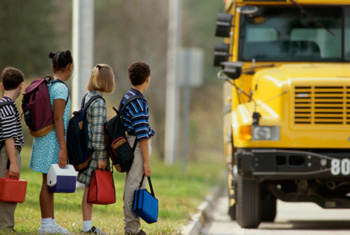It's a New Day in Public Health.
The Florida Department of Health works to protect, promote, and improve the health of all people in Florida through integrated state, county, and community efforts.
Kids and Backpacks: Tips to Protect Your Child’s Health
September 26, 2013

Today, backpacks are a necessity for students as the use of lockers is quickly becoming a thing of the past. Each day, more than 79 million students in the United States carry personal backpacks to school. Many students are transporting not only textbooks and other necessary classroom supplies, but also laptops and other electronic learning devices which add weight to an already heavy backpack.
According to the Consumer Product Safety Commission, during 2012 more than 24,000 people were treated in U.S. hospitals and doctors’ offices for backpack-related injuries. Of those patients, more than 9,500 were between the ages of five and 18.
Some signs that a backpack is too heavy:
- Your child has to struggle to get the pack on or off.
- They have to lean forward in order to carry the backpack.
- They complain of back pain.
A backpack that is too heavy or worn on just one shoulder can have potentially serious health effects for kids and teens. Tingling arms and fingers, neck, shoulder and back aches, or altered posture are all symptoms kids can experience. Parents can help kids re-pack for better weight and balance, and can also show them the safest way to wear their pack to avoid these health problems.
- The American Occupational Therapy Association recommend that kids carry packs of no more than 10 to 15 percent of their body weight (100 pound student = 10 pound backpack). And, less is always better.
- Different ages need different size backpacks. Be sure to choose one that is the right size, well-padded and has enough storage to meet your child’s needs.
- Load heaviest items at the back of the pack, so they are closest to the child’s back. And again, make sure they only carry what is necessary for the day’s activities.
- Adjust the straps for a better fit. The bottom of their backpack should rest in the curve of their lower back and no more than 2–3 inches below their waistline.
- Kids and teens should always wear both straps of their backpack—one on each shoulder—so the load is spread evenly across the back. If your child uses a single strap backpack, it should be as small and light as possible.
An overly heavy backpack can also cause kids to accidentally trip and fall, or accidentally injure another student with the pack. If your child complains of back pain or numbness or weakness in the arms or legs, be sure to talk to your doctor or licensed physical therapist.
National School Backpack Awareness Day was September 18, 2013 and is sponsored by the American Occupational Therapy Association. For more information, please visit their website at http://www.aota.org/Conference-Events/Backpack-Safety-Awareness-Day.aspx.
Bottom Line: Packing and wearing a backpack properly is the best way to avoid these potential health risks for kids and teens. Take a few moments with your student today to ensure they are healthy and safe throughout the school year!




Connect with DOH